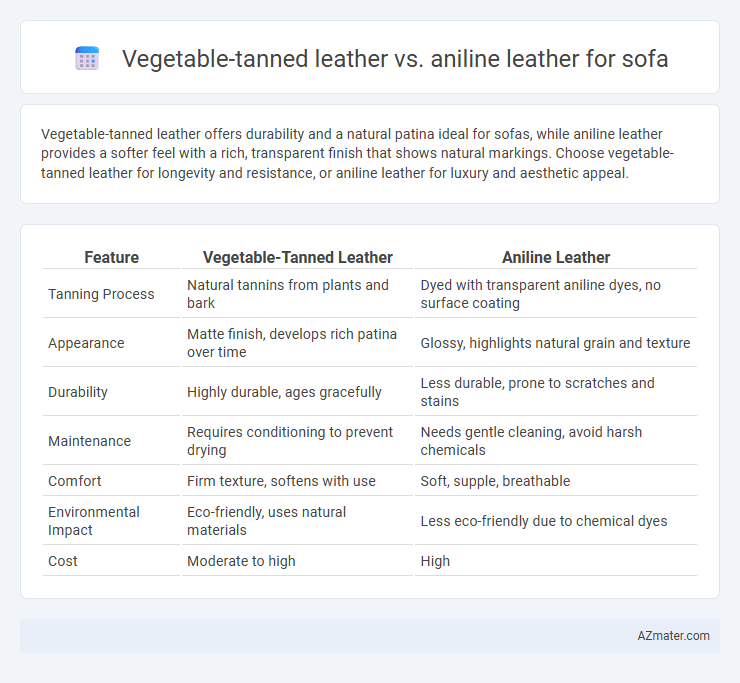Vegetable-tanned leather offers durability and a natural patina ideal for sofas, while aniline leather provides a softer feel with a rich, transparent finish that shows natural markings. Choose vegetable-tanned leather for longevity and resistance, or aniline leather for luxury and aesthetic appeal.
Table of Comparison
| Feature | Vegetable-Tanned Leather | Aniline Leather |
|---|---|---|
| Tanning Process | Natural tannins from plants and bark | Dyed with transparent aniline dyes, no surface coating |
| Appearance | Matte finish, develops rich patina over time | Glossy, highlights natural grain and texture |
| Durability | Highly durable, ages gracefully | Less durable, prone to scratches and stains |
| Maintenance | Requires conditioning to prevent drying | Needs gentle cleaning, avoid harsh chemicals |
| Comfort | Firm texture, softens with use | Soft, supple, breathable |
| Environmental Impact | Eco-friendly, uses natural materials | Less eco-friendly due to chemical dyes |
| Cost | Moderate to high | High |
Overview: Understanding Vegetable-Tanned vs Aniline Leather
Vegetable-tanned leather is crafted using natural tannins from plant materials, offering durability and a rich patina over time, making it ideal for high-quality sofas. Aniline leather is dyed with soluble dyes that preserve the hide's natural texture and softness, providing a luxurious and supple feel but with less resistance to stains and wear. Choosing between these leathers depends on the balance between durability, appearance, and maintenance preferences for sofa upholstery.
Leather Production Methods: Key Differences
Vegetable-tanned leather undergoes a natural tanning process using plant-based tannins, resulting in a firm, durable material with a rich, earthy tone that develops a unique patina over time. Aniline leather is treated with soluble dyes that penetrate the hide without covering the surface with a protective topcoat, preserving the leather's natural texture and markings but making it more susceptible to stains and fading. The key difference lies in vegetable tanning's environmentally friendly method and enhanced durability versus aniline's emphasis on natural appearance and softness.
Appearance and Aesthetics
Vegetable-tanned leather showcases a natural, rich patina that deepens over time, offering a rustic and organic aesthetic ideal for vintage or classic sofa designs. Aniline leather boasts a smooth, soft surface with a uniform color and visible natural grain, providing a luxurious and minimalist appearance favored in modern and high-end sofas. While vegetable-tanned leather emphasizes texture and character variations, aniline leather highlights clarity and a sleek finish, directly influencing the sofa's overall visual appeal.
Durability and Longevity
Vegetable-tanned leather offers superior durability due to its natural tanning process that results in a thicker, firmer material resistant to wear and tear, making it ideal for high-traffic sofas. Aniline leather, while softer and more supple with a natural finish, is more susceptible to stains and scratches, requiring careful maintenance to preserve its appearance over time. For longevity in sofa upholstery, vegetable-tanned leather provides a more robust and long-lasting option, balancing strength and aging beautifully without significant compromise in comfort.
Comfort and Softness
Vegetable-tanned leather offers a firm texture with natural breathability, providing durability but a slightly stiffer feel compared to aniline leather. Aniline leather is renowned for its supreme softness and supple comfort due to minimal surface treatment, allowing the natural grain and softness to remain intact. For sofa upholstery, aniline leather delivers a luxurious, cozy seating experience, while vegetable-tanned leather ensures long-lasting support with a more structured touch.
Maintenance and Care Requirements
Vegetable-tanned leather requires regular conditioning to maintain its natural oils and prevent drying or cracking, while aniline leather needs gentle cleaning with mild soap and water due to its untreated surface that easily absorbs stains. Both types should be kept away from direct sunlight and heat sources to avoid fading and damage, but aniline leather demands more frequent maintenance because of its delicate finish. Using appropriate leather care products specifically designed for either vegetable-tanned or aniline leather ensures longevity and preserves the sofa's aesthetic appeal.
Environmental Impact and Sustainability
Vegetable-tanned leather uses natural tannins from plant sources, resulting in a biodegradable and eco-friendly tanning process that minimizes harmful chemical release and water pollution compared to traditional chrome tanning. Aniline leather, dyed with soluble dyes without a surface coating, maintains the natural hide but often involves significant use of chemicals and water resources during finishing, impacting environmental sustainability less favorably than vegetable tanning. Choosing vegetable-tanned leather for sofas supports sustainable production practices through reduced chemical usage and enhanced biodegradability, aligning with environmentally conscious consumer demands.
Cost Comparison
Vegetable-tanned leather typically costs more than aniline leather due to the lengthy, natural tanning process that enhances durability and develops a unique patina over time. Aniline leather, though softer and more breathable, involves less processing, making it more affordable but less resistant to stains and fading. When choosing between the two for a sofa, vegetable-tanned leather represents a higher upfront investment balanced by long-term value, while aniline leather offers budget-friendly softness with higher maintenance requirements.
Suitability for Different Interior Styles
Vegetable-tanned leather offers a natural, rustic appearance ideal for traditional, farmhouse, or vintage-style interiors, enhancing warmth and character through its unique patina over time. Aniline leather, renowned for its smooth, soft texture and rich color depth, suits modern, minimalist, or contemporary spaces by providing a sleek and luxurious aesthetic. Choosing between vegetable-tanned and aniline leather for sofas depends on the desired ambiance, durability needs, and compatibility with the interior design palette.
Which Leather is Best for Your Sofa?
Vegetable-tanned leather offers durability and develops a rich patina over time, making it ideal for those seeking long-lasting, natural aging in their sofa upholstery. Aniline leather provides a soft, luxurious feel with a natural look due to minimal surface treatment but requires careful maintenance to prevent stains and fading. Choosing the best leather for your sofa depends on your lifestyle preferences and willingness to invest in upkeep, with vegetable-tanned leather suited for high-traffic use and aniline leather best for low-traffic, elegant settings.

Infographic: Vegetable-tanned leather vs Aniline leather for Sofa
 azmater.com
azmater.com